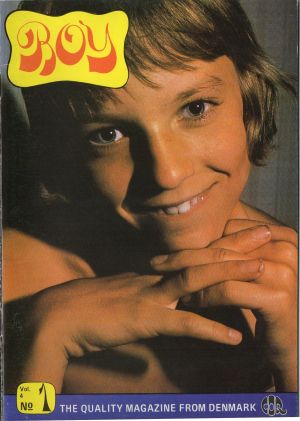One of our staff members is contributing considerably to a News Archiving service at Mu. Any well educated (Masters, PhD or above) users who wish to make comments on news sites, please contact Jim Burton directly rather than using this list, and we can work on maximising view count.
Child Pornography: Difference between revisions
The Admins (talk | contribs) No edit summary |
The Admins (talk | contribs) No edit summary |
||
| Line 1: | Line 1: | ||
[[Image:Boymag.jpg|thumb|Actual legalization-era magazine from Denmark]] | [[Image:Boymag.jpg|thumb|Actual legalization-era magazine from Denmark]]__NOTOC__ | ||
'''"Child Pornography"''' ('''CP''') is a broad term which refers to [[nude]], [[sexual]], or [[pornographic]] depictions of [[child]]ren, [[minor]]s, or [[person]]s under the age of consent. The definition varies across jurisdictions, often with regard to moral and cultural sensibilities such as perceptions of nudity or appropriate ages for sexual activity. There are also a number of specific crimes related to child pornography; for example - "making" images and distributing them. In many cases the laws pertaining to these things use different labels and CP remains a colloquial term. | '''"Child Pornography"''' ('''CP''') is a broad term which refers to [[nude]], [[sexual]], or [[pornographic]] depictions of [[child]]ren, [[minor]]s, or [[person]]s under the age of consent. The definition varies across jurisdictions, often with regard to moral and cultural sensibilities such as perceptions of nudity or appropriate ages for sexual activity. There are also a number of specific crimes related to child pornography; for example - "making" images and distributing them. In many cases the laws pertaining to these things use different labels and CP remains a colloquial term. | ||
==Politically correct | ==Etymology== | ||
Etymologically speaking, the term "pornographos" referred to depictions of harlots (prostitutes) in Ancient Greece. Labelling child images as pornography (calling them whores, essentially) contradicts the thought process that children cannot consent to sex. Prostitutes must by definition by consensually selling sex, otherwise it is rape and not prostitution. People who are sold as objects without their consent are called sex slaves, not prostitutes. | |||
==Politically correct alternatives== | |||
More recently, a politically correct term, '''CSAM''' (Child Sexual Abuse Material) has come into use. However, since most such material is now produced by minors, | More recently, a politically correct term, '''CSAM''' (Child Sexual Abuse Material) has come into use, particularly by eliminationists such as [[INHOPE]]. However, since most such material is now produced by minors, this term, and the idea that all such material can be eliminated, is inherently problematic and has implications for civil liberties. It should also be noted that most such minor pornographers are in fact teenagers and not children, and that some investigations would appear to contest the idea that the rarer, adult produced "CSAM" is [[Research: Double-Taboo CSA|necessarily "abusive" in anything but a statutory sense]]. | ||
== | ===Youth Erotica=== | ||
A more accurate term for the genre would be "Youth Erotica", although this, or similar terms have not seen widespread use, due to the legal schemes in most western countries (see [[Child Pornography Laws]], particularly [[Wikipedia:Legality of child pornography]]). | |||
==List== | ==List== | ||
Revision as of 16:21, 9 May 2022

"Child Pornography" (CP) is a broad term which refers to nude, sexual, or pornographic depictions of children, minors, or persons under the age of consent. The definition varies across jurisdictions, often with regard to moral and cultural sensibilities such as perceptions of nudity or appropriate ages for sexual activity. There are also a number of specific crimes related to child pornography; for example - "making" images and distributing them. In many cases the laws pertaining to these things use different labels and CP remains a colloquial term.
Etymology
Etymologically speaking, the term "pornographos" referred to depictions of harlots (prostitutes) in Ancient Greece. Labelling child images as pornography (calling them whores, essentially) contradicts the thought process that children cannot consent to sex. Prostitutes must by definition by consensually selling sex, otherwise it is rape and not prostitution. People who are sold as objects without their consent are called sex slaves, not prostitutes.
Politically correct alternatives
More recently, a politically correct term, CSAM (Child Sexual Abuse Material) has come into use, particularly by eliminationists such as INHOPE. However, since most such material is now produced by minors, this term, and the idea that all such material can be eliminated, is inherently problematic and has implications for civil liberties. It should also be noted that most such minor pornographers are in fact teenagers and not children, and that some investigations would appear to contest the idea that the rarer, adult produced "CSAM" is necessarily "abusive" in anything but a statutory sense.
Youth Erotica
A more accurate term for the genre would be "Youth Erotica", although this, or similar terms have not seen widespread use, due to the legal schemes in most western countries (see Child Pornography Laws, particularly Wikipedia:Legality of child pornography).
List
For a comprehensive list of articles, see Category:Child_Pornography.
To avoid confusion of this topic, we constructed a series of articles that relate to this issue:
- Child Pornography Laws - Links to present laws.
- Indecent images of children - UK Laws in focus.
- Research: Child Pornography
- Child Pornography (Wikipedia) - Archive of an old Wikipedia article (Censored article, as of 2008).
In addition to this, all of the following may or may not be considered child porn:
- Boy Photography
- Girl Photography
- Non-photographic erotica involving minors, including literature and cartoons.